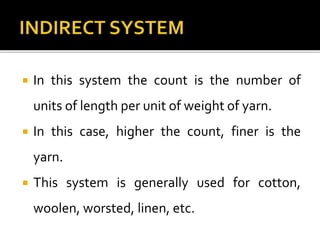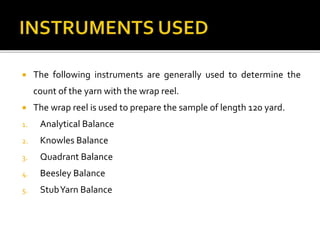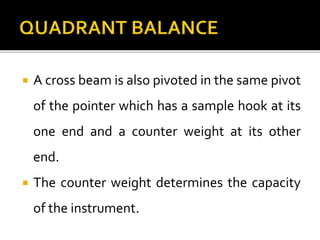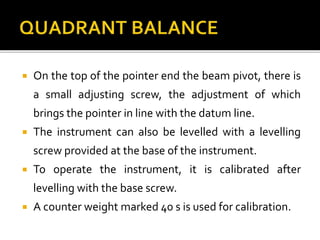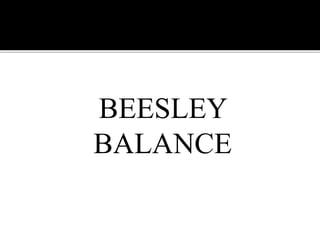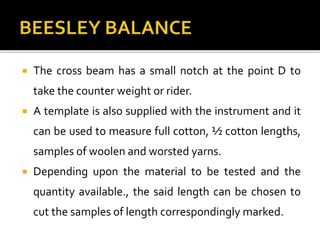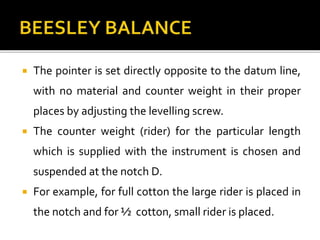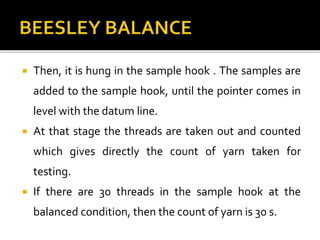Yarn testing
- 1. Prepared by
- 3. The count of yarn is a numerical expression which defines its fineness. It is also called as yarn number or linear density. According to the definition given by the Textile Institute, Count is a number indicating the mass per unit length or the length per unit mass of yarn.
- 4. Several systems and units are used for expressing the yarn number, depending on the material used for preparing the yarn and the locality where the yarn has been manufactured. All these systems are grouped into the following categories: 1. Indirect system 2. Direct system 3. Universal system
- 5. In this system the count is the number of units of length per unit of weight of yarn. In this case, higher the count, finer is the yarn. This system is generally used for cotton, woolen, worsted, linen, etc.
- 6. The weight of the fabric can be calculated easily, when the count of warp and weft yarns are expressed in this system. The amount of twist in the yarn and cloth setting (threads per inch) are directly proportional to the square root of the yarn count and they can easily calculated.
- 7. The count does not express the size of the yarn directly. A coarser or bulky yarn will have a small count number than a finer or less bulky yarn. When the component threads are of different counts, it is difficult to calculate the resultant count of the folded yarn in this system.
- 8. In this system, the count of the yarn is the number of units of weight per unit length of yarn. This system is used for silk, jute, etc.
- 9. The count directly expresses the size of the yarn. A coarser yarn will have a higher number while a finer yarn will have a lower number. The resultant count of the folded yarn can be easily calculated even if the component threads are of different counts.
- 10. It is difficult to calculate the weight of the fabric. Calculation of the amount of twist in the yarn and the cloth setting are comparatively difficult in this system.
- 11. Tex system of yarn numbering is called as universal system. This is a direct system of yarn numbering and is introduced by International Standards Organization and various organizations of textile scientists., technologists and manufacturers. The merits and demerits of direct system of yarn numbering are also applicable to universal system.
- 12. This system is applicable to yarns made from natural as well as synthetic fibres and hence useful for replacing the several different systems which are being used in the various sectors of the textile industry all over the world.
- 13. Tex system can be used from fibre to yarn stage. The fineness of fibre can be expressed in terms of millitex, i.e., weight of fibre in mg in one km length and the fineness of cords, ropes and twines, etc. are expressed in terms of Kilotex, i.e., the weight of the material in kg in one km length.
- 14. The following instruments are generally used to determine the count of the yarn with the wrap reel. The wrap reel is used to prepare the sample of length 120 yard. 1. Analytical Balance 2. Knowles Balance 3. Quadrant Balance 4. Beesley Balance 5. StubYarn Balance
- 16. In the mills, the leas of yarn are wrapped using the wrap reel and their weight are found out using the analytical balance. The weights are measured in terms of grains and the count is calculated using the formula. Count (Ne) = 1000/Weight of lea in grains For internal routine testing purposes, this may be considered sufficiently accurate for the end in view.
- 17. QUADRANT BALANCE
- 18. If the sample is available with length less than 120 yards, then quadrant balance can be used to determine its count. This is a direct yarn count balance. It consists of a quadrant scale fixed to the pillar. At the top of the pillar, pointer is pivoted so that it moves over the face of the quadrant scale.
- 19. A cross beam is also pivoted in the same pivot of the pointer which has a sample hook at its one end and a counter weight at its other end. The counter weight determines the capacity of the instrument.
- 20. The quadrant scale is divided into three scales. The top scale can be used to find the weight per square yard of a cloth sample in ounces. The middle scale is used to find the count of yarn of length 8 yards and the third scale to find the count of yarn of length 40 yards.
- 22. On the top of the pointer end the beam pivot, there is a small adjusting screw, the adjustment of which brings the pointer in line with the datum line. The instrument can also be levelled with a levelling screw provided at the base of the instrument. To operate the instrument, it is calibrated after levelling with the base screw. A counter weight marked 40 s is used for calibration.
- 23. For this the counter weight is suspended from the sample hook. If the balance is level, the pointer reads 40 s on the 40 yard scale. If it does not read 40 s, the pivot of the pointer is adjusted until it reads 40 s on the 40 yards scale. If a sample of length 8 yards is used, its count can be noted from the 8 yards scale and if the sample of length 40 yards is used its count can be noted from 40 yards scale.
- 24. BEESLEY BALANCE
- 25. It is working on the principle of fixed weight and fixed length system. It is used for assorting the count of warp and weft yarns from a small sample of fabric. It consists of a pillar A which carries a cross beam B, fulcrummed at knife edge at the point G.
- 26. At one end the cross beam is a hook E upon which the yarn to be tested can be placed. The other end of the beam tappers to a point C. When the beam is in balance, the pointer will coincide with the datum line or the arrow mark on the beam. The pillar is mounted on the base. The whole instrument is levelled by a levelled screw at one end of the base.
- 28. The cross beam has a small notch at the point D to take the counter weight or rider. A template is also supplied with the instrument and it can be used to measure full cotton, ½ cotton lengths, samples of woolen and worsted yarns. Depending upon the material to be tested and the quantity available., the said length can be chosen to cut the samples of length correspondingly marked.
- 29. The pointer is set directly opposite to the datum line, with no material and counter weight in their proper places by adjusting the levelling screw. The counter weight (rider) for the particular length which is supplied with the instrument is chosen and suspended at the notch D. For example, for full cotton the large rider is placed in the notch and for ½ cotton, small rider is placed.
- 30. Then, it is hung in the sample hook . The samples are added to the sample hook, until the pointer comes in level with the datum line. At that stage the threads are taken out and counted which gives directly the count of yarn taken for testing. If there are 30 threads in the sample hook at the balanced condition, then the count of yarn is 30 s.
- 31. THANK YOU




